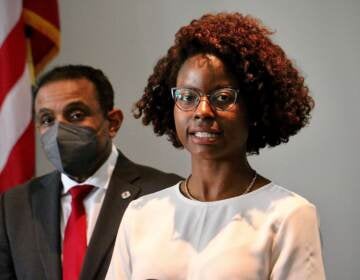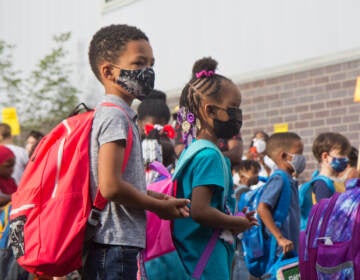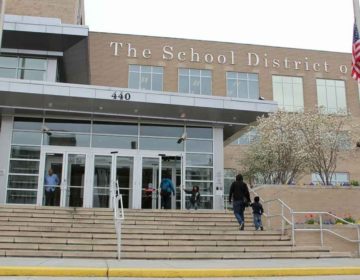Hot air or actual solution? Experts on Philly’s plan to ventilate schools during COVID
Pictures of flimsy-looking window fans for the School District of Philadelphia angered many. Experts, however, say they can be effective — if used properly.
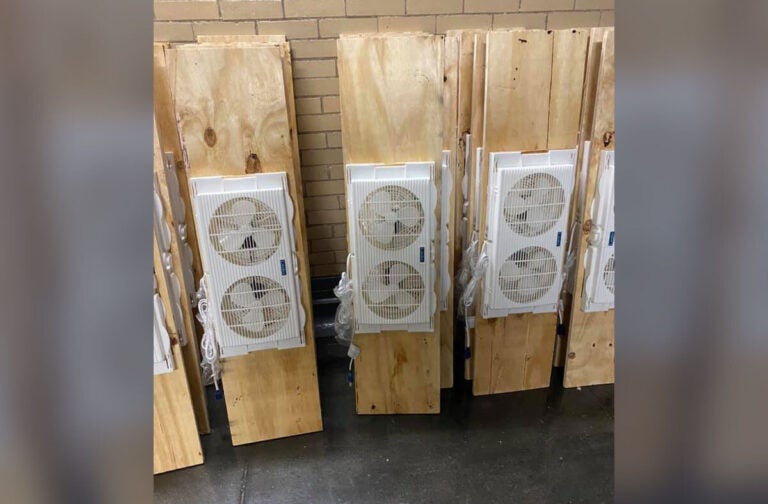
Window fans for ventilation are part of the School District of Philadelphia's controversial return to in-person learning plan. (Twitter/@Philly_RJ)
Ask us about COVID-19: What questions do you have about the current surge?
They blew onto the internet with fury.
Pictures of window fans — gathered by the dozens and sitting outside Philadelphia classrooms — circulated online over the weekend and prompted outrage.
The fans were waiting to be installed in the windows of Philadelphia public school buildings — part of the district’s plan to increase ventilation in its old school buildings and prepare those buildings for a planned reopening on Feb. 22.
About 1,100 fans will be installed across the district, according to Chief Operating Officer Reginald McNeil. They’re slated for spaces where there’s no functional ventilation system.
Critics have railed against the fans as unimpressive and basic.
And after Superintendent William Hite promised devices that would both blow air and simultaneously measure airflow, many felt the district had pulled a fast one. Promise a high-tech solution, deliver a cheap fix.
Hite later apologized, saying he made a “mistake” when he told a board member last week that the fans would have gauges on them.
All of this leaves several questions unanswered:
Are window fans a good way to boost ventilation in Philadelphia classrooms? Will they help reduce the risk posed by COVID-19? And does the district’s approach to ventilation make sense?
We asked experts in an attempt to sort through perception, reality, and uncertainty.
Question 1: Are window fans a useful tool?
The quick answer is yes.
Window fans introduce outside air. Outside air is extremely unlikely to carry pathogens. So this clean air dilutes the air inside and can reduce the risk of COVID-19 transmission.
In its recommendations for school safety, Harvard’s T.H. Chan School of Public Health specifically mentioned window fans as a potential intervention.
“They’re pushing through fresh air, which is the job of ventilation,” said Mark Hernandez, a professor of civil and environmental engineering at the University of Colorado who has worked with school districts on ventilation. “While they might not [look] so effective, they can be really effective.”
William Bahnfleth, a professor of architectural engineering at Penn State, called window fans a “very legitimate strategy” for increasing ventilation.
Question 2: Could window fans cause other problems?
The answer here is also yes.
Window fans create a current of directional airflow.
It’s great to blow in the fresh air, but if you blow that air directly onto a person it can make things worse. Perhaps the person has COVID-19 but doesn’t know it. If that unwittingly sick person sits in front of the fan, people downstream can catch the virus.
“We don’t want air washing from one side of the room over the other with strong currents,” said Corey Metzger, who is leading a school safety team on an epidemic task force convened by the American Society of Heating, Refrigerating and Air-Conditioning Engineers (ASHRAE).
The best way to mitigate this, experts say, is to arrange fans strategically.
Point them toward the back of the classroom or toward the ceiling. That way you create air “turbulence” instead of pushing all the fresh air in one direction.
Reginald McNeil with the School District of Philadelphia said the district has made these allowances, installing fans at the back of classrooms. In some rooms, he said, the windows open outward, allowing fans to be installed so that they point up at the ceiling. That’s a good technique, experts say.
Hernandez, from the University of Colorado, said it might be better to have several fans blowing at low speeds, rather than just one. Jerry Roseman, the environmental scientist with the Philadelphia Federation of Teachers, made a similar suggestion.
“I’d bring in lower-volume fans,” said Roseman, who also questioned whether the fans were sturdy enough to withstand constant use in a school setting.
Part of Roseman’s fear is that the district’s fans will channel outside air at too fast a rate, potentially leading to strong air currents.
“Think of it as the air hose for your tires,” said Roseman. “It’s blowing air out at a fairly high linear velocity.”
Roseman and other experts also pointed out that fans could falter in the rain or introduce air that is insufferably cold or hot.
“You’re gonna have days where you probably can’t run that fan and expect it to not be spitting moisture into the building,” Metzger said.
Bahnfleth from Penn State worries about temperature control. Fresh air is great, but in the right season.
“In the middle of the winter it can cause real comfort issues,” said Bahfleth, who chairs ASHRAE’s epidemic task force. “Instead of spending money on air cleaners you’re gonna ask people to spend money on warmer clothing.”
Question 3: Does the district’s approach to ventilation make sense?
Here’s where things get more complicated.
On the one hand, the School District of Philadelphia has taken a more scientific and rigorous approach to ventilation than some others.
Philadelphia has gone into its classrooms and conducted something called an “air-balancing test” to determine how much fresh air circulates through a given space. The district then uses that reading to determine how many people can safely occupy that space.
The standard the district uses is 15 cubic feet of fresh airflow per minute per person, which is a threshold set by the American Society of Heating, Refrigerating and Air-Conditioning Engineers (ASHRAE) and tied roughly to an assumption that a room is designed to have 25 people per 1000 square feet of floor area.
Cities like New York and Chicago took inventory of which classrooms had windows or functioning HVAC. Chicago measured the humidity, temperature, carbon monoxide level, and particulate matter in its classrooms.
Neither district, however, tried to actually gauge fresh airflow.
Hernandez said Denver’s public schools — which he’s helped advise during the pandemic — measured airflow in a representative sample of classrooms. He commended Philadelphia for measuring more spaces and using a scientific baseline to guide its decision-making around which schools needed extra ventilation.
“That’s an evidence-based, informed approach with a good measurement,” Hernandez said.
District’s COO Reginald McNeil said he wasn’t aware of any other district that’s taken the time to measure airflow in every space.
“I haven’t come across one that I’ve spoken with that said they’ve applied this additional measure, which is the ventilation assessment by certified air balancers to determine the condition of their mechanical ventilation systems,” McNeil said.
But there are legitimate questions about the scientific standard Philadelphia is using here.
ASHRAE’s threshold of 15 cubic feet per minute per person is a generalized standard, created before COVID-19. Hernandez called it an “aesthetic” standard and said there’s long been conversation around raising it. Bahnfleth said it’s a threshold designed around odor — basically the type of airflow you need for a room to smell fresh.
And the threshold isn’t related to COVID — it’s more a general standard for measuring the quality of ventilation in a space.
“We feel as though it’s a helpful, baseline starting point,” said Metzger, who is on the ASHRAE taskforce.
Bahnfleth from Penn State called the district’s approach a “good faith effort.”
But he thinks the district should have interpreted its data differently. Instead of using the ASHRAE standard for cubic feet per minute per person, Bahnfleth thinks the district should have measured air exchanges per hour, a rate that calculates how often the volume of air in a given room is replaced by new air.
He believes it’s a better approximation of the risk each individual faces. Harvard and the University of Colorado teamed up to create an air-exchange calculator so that districts could determine whether a given space has five total air changes per hour or greater, the benchmark that researchers decided separated spaces with “excellent” ventilation and those without.
There’s also a question of whether the district should focus on ventilation or filtration.
Some districts — like Chicago, for instance — have invested in air purifiers that filter out pathogenic particles, providing another layer of assurance.
McNeil said the district is “looking at” air purifiers, but so far it’s prioritized ventilation.
Experts hesitate to say whether one approach is better than the other. It may just depend on the space.
In rooms with ample ventilation, a filtration device won’t add much, said Hernandez.
“Filters are supplemental to ventilation,” he said. “They don’t replace ventilation. Filters lose effectiveness as ventilation comes up. There’s a sweet spot for them.”
But in the right context, a filtration device can be helpful.
Question 4: Do these interventions make up for the fact that Philly school buildings are old?
There’s no one way to answer this question. But the age and condition of Philadelphia’s school buildings have limited the district’s options.
For instance, the school district isn’t able to install filters in its mechanical ventilation systems because those systems are too old to accommodate them, said McNeil, the COO. Using modern filters on the district’s old systems would create “backflow” that would ultimately make them less effective, McNeil explained.
“Our mechanical ventilation systems are extremely antiquated,” said McNeil. “We have to work with what we have. So we resurrected a lot of our mechanical ventilation systems.”
Bahnfelth from Penn State said it might be useful to install lower-quality filters in older systems, even if they don’t meet the established filtration standards for COVID protection. Some protection is better than none. But that approach would require individual solutions for individual systems, a process that takes considerable time and money.
Philadelphia’s approach has basically been twofold. First, officials try to make mechanical repairs to existing ventilation systems. Second, they install fans in places where there is no functioning ventilation system. Even if a fan might be a smart solution, the limitations remain.
The historical context underlying the public’s skepticism of the district’s fan plan is impossible to ignore. For many, the school leaders have lost the benefit of the doubt when it comes to building upkeep.
The district has billions in deferred maintenance, a legacy of old infrastructure and underfunding. But the district also mishandled some of the maintenance it has performed recently, according to an investigation by The Philadelphia Inquirer. The most glaring example came during the renovation of Ben Franklin High School, which led to the discovery of exposed asbestos and the temporary displacement of 1,000 children.
How much this matters in the grand scheme of reopening schools, is another massive question mark.
Ventilation is one part of the equation, alongside social distancing and masks.
New York City — another large east coast district with old buildings — has managed to keep some students in school for most of the year. The test-positivity rate in the system is just 0.54%. Scientific studies — from places as diverse as Norway, North Carolina, and rural Wisconsin — suggest schools are not drivers of COVID transmission. Some researchers say people are safer in schools than they are in the broader community.
Philadelphia teachers and parents wonder if that broader science applies in a district that’s long struggled to meet basic maintenance standards.
Fans or no fans, those doubts will be difficult to erase.

Get daily updates from WHYY News!
WHYY is your source for fact-based, in-depth journalism and information. As a nonprofit organization, we rely on financial support from readers like you. Please give today.



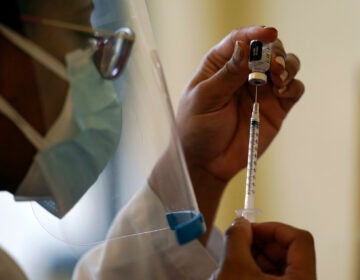

![CoronavirusPandemic_1024x512[1]](https://whyy.org/wp-content/uploads/2020/03/CoronavirusPandemic_1024x5121-300x150.jpg)
